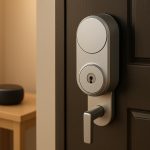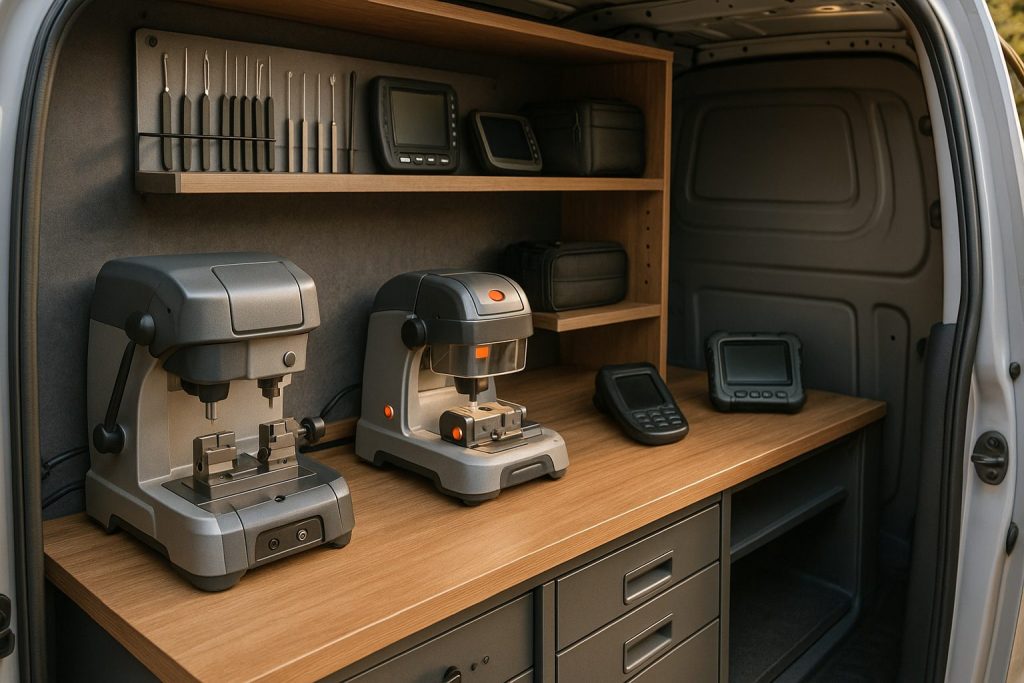Mobile locksmithing tools are the backbone of on-demand locksmith services, enabling professionals to handle emergencies like lockouts, broken keys, and advanced security systems directly on-site. These tools are designed for portability and efficiency, covering everything from traditional lock-picking to high-tech key cutting and programming. Here’s what you need to know:
- Key Functions: Tools are categorized for entry, key extraction/rekeying, and lock installation.
- Modern Necessities: Portable key cutting machines, transponder programmers, and diagnostic tools are essential for handling advanced locks and vehicles.
- Tool Organization: A well-arranged van layout with secure storage ensures quick access and protects equipment during transit.
- Maintenance: Regular cleaning, calibration, and updates keep tools reliable and extend their lifespan.
- Backup Planning: Always carry spare tools and offline resources to remain operational during unexpected challenges.
Investing in the right tools and maintaining a smart, organized setup ensures locksmiths can deliver fast and dependable service wherever they’re needed.
Mobile Locksmith Van Setup on a Budget: Bought, Built & Reused!
Must-Have Tools for a Mobile Locksmith Kit
A well-prepared mobile locksmith kit is crucial for delivering quick and efficient service on-site. To handle the diverse challenges of the job, professional locksmiths need tools that cover three main tasks: gaining entry, removing or replacing components, and installing new hardware. Here’s a breakdown of the essential tools organized by their primary functions.
Lock Picking and Bypass Tools
Locksmiths rely on a variety of lock picks, including hook, rake, and diamond picks, to handle different lock mechanisms. Tension wrenches are just as vital, with both top-of-keyway and bottom-of-keyway options offering the flexibility needed for various lock orientations.
For automotive locks, slim jims work well on older vehicles, but modern cars often require specialized tools like air wedges, which come in different sizes to fit various scenarios. Bump keys are another effective option for pin tumbler locks, especially when paired with bump hammers or bump guns, which deliver more consistent results than improvised methods.
When dealing with advanced access systems, RFID cloners and proximity card readers are indispensable. However, these tools must be used responsibly, with proper training and authorization to ensure legal compliance.
Key Extraction and Rekeying Tools
After gaining access, locksmiths often need tools for key extraction and rekeying. Broken key extractors, available in spiral, hook-style, and needle-nose designs, are essential for removing snapped keys from locks.
Pinning kits are a cornerstone of rekeying, allowing locksmiths to save customers the expense of replacing entire locks. These kits typically include pins in standard sizes (1 through 9), springs, and key pins. Durable materials like brass for bottom pins and nickel-plated brass for top pins ensure reliability in high-use locks.
To streamline rekeying, plug followers prevent pins from falling into the lock body when the plug is removed. Universal plug followers are versatile, but having brand-specific followers for locks like Schlage and Kwikset can speed up the process. Additionally, pinning tweezers with magnetic tips make handling small pins easier, though non-magnetic tweezers are necessary when working near sensitive electronic components.
Installation and Servicing Tools
Sometimes, non-destructive entry methods aren’t an option. In such cases, drilling equipment becomes essential. A cordless drill with variable speed control offers precision and prevents overheating, while carbide-tipped drill bits in sizes like 1/8", 3/16", and 1/4" handle most drilling needs.
For new lock installations, hole saws are a must. Standard door prep usually requires a 2-1/8" hole for the lock body and a 1" hole for the deadbolt. Bi-metal hole saws are more durable than carbon steel versions, especially when working on metal doors or reinforced frames.
A reliable screwdriver set with Phillips and flathead bits in multiple sizes is indispensable for hardware installation. Additional tools like hammers, chisels, and wood-boring bits are useful for modifying door frames when needed. Measuring tools such as tape measures and door thickness gauges ensure precise cuts and proper fitting.
To finish the job professionally, files and sandpaper help smooth out rough edges from drilling or cutting. Metal files are ideal for steel components, while wood files and sandpaper in varying grits (coarse to fine) are perfect for wooden doors and frames.
An effective mobile locksmith kit strikes a balance between being comprehensive and portable. By choosing multi-purpose tools, locksmiths can reduce service times, improve efficiency, and leave customers satisfied with their work.
Key Cutting and Programming Equipment
When it comes to mobile locksmithing, being equipped to cut and program keys on-site is what sets true professionals apart. Modern locksmithing isn’t just about unlocking doors; it requires tools that can handle everything from simple house keys to advanced automotive transponders. The right equipment transforms a basic service call into a complete solution. Below, we’ll explore the essential tools that allow mobile locksmiths to deliver top-notch services wherever they’re needed.
Portable Key Cutting Machines
Battery-powered key cutting machines are a game-changer for mobile locksmiths. These compact and lightweight tools deliver the same precision you’d expect in a shop, but with the freedom to work anywhere – no external power source required.
A key feature to look for is a 4-way jaw system, which allows technicians to cut a variety of keys, including residential, commercial, high-security, and even laser-cut keys. This versatility means fewer tools are needed, which is a big plus when you’re on the move. And for those tricky automotive keyways, like GM or Toyota, adapters can extend the machine’s capabilities.
Portability is crucial, and these machines are designed to be easy to carry without sacrificing performance. Whether it’s a house key or a high-security car key, these machines ensure locksmiths are ready for any challenge.
Transponder Programming Tools
With modern vehicles relying heavily on transponder technology, having the right programming tools is non-negotiable. These devices sync new keys with a car’s immobilizer system, ensuring the vehicle recognizes and accepts the replacement key.
Advanced transponder programmers often come with EEPROM capabilities, which allow locksmiths to read, modify, and write data directly onto a vehicle’s immobilizer chip. This is especially handy when dealing with lost keys or malfunctioning systems.
Another key advantage is that these tools often receive software updates, keeping them compatible with the latest vehicle models and security protocols. Plus, multi-protocol support means one device can work across multiple car brands, making it an indispensable part of a mobile locksmith’s toolkit.
Code Retrieval and Cutting Software
Cutting a key accurately starts with having the right bitting code, which specifies the depth and spacing of each cut. Professional code retrieval systems give locksmiths access to extensive manufacturer databases filled with these specifications.
Many software solutions can directly integrate with portable key cutting machines, ensuring precision by providing exact measurements for each key type. This removes the guesswork and significantly improves the chances of a perfect cut on the first try.
With real-time database access via mobile hotspots or cellular connections, technicians can retrieve up-to-date codes on-site. And for areas with poor connectivity, offline functionality ensures they always have access to critical key data.
This seamless integration between code retrieval software and cutting machines streamlines the entire process. Locksmiths can quickly transfer data, cut keys accurately, and save valuable time – all while enhancing customer satisfaction with efficient, reliable service.
Organizing, maintaining, and protecting your mobile toolkit is essential for keeping your operation running smoothly. A well-arranged mobile setup not only looks professional but also boosts efficiency and reliability. In the U.S., equipping a mobile locksmith van typically costs between $10,000 and $12,000. A thoughtfully designed van layout can make all the difference in managing tools effectively and minimizing risks.
Van Layout and Tool Storage
The backbone of a productive mobile operation is a smartly designed van layout. Think of your van as a compact workshop where every inch counts – quick access to tools can significantly cut down response times.
Start by designating a "daily-use" zone on the driver’s side. Install shallow shelves and bins at eye level for frequently used items like lock picks, plug followers, and pinning kits [10,11]. The passenger side or rear section can house bulkier equipment like installation jigs, cordless tools, portable key cutters, and programming devices. For heavy machinery, such as key cutters, mount them near the rear doors to simplify loading and ensure proper ventilation.
To keep your tools safe and secure while on the road, invest in steel or aluminum racks with adjustable shelving. Use lockable drawers to protect hand tools, and for precision equipment like key cutters, consider vibration-damped plates or bolted benches to maintain their calibration.
Small parts need special care to prevent loss during transit. Use labeled and color-coded bins for storing pins and key blanks [10,11]. Many locksmiths recommend foam shadow boards for organizing picks and extractors – this way, you’ll immediately notice if a tool is missing. Magnetic strips near the workbench can hold screwdrivers and tweezers, while duplicate "hot bins" stocked with commonly used items can save time during busy jobs.
sbb-itb-643e28e
Tool Maintenance and Calibration
Regular maintenance is a must to extend the life of your tools and ensure accuracy on the job. After each use, clean cutters and deburr wheels when they start to dull [10,11]. Monthly, lubricate tools like plug followers, pick hinges, and plug spinners with a non-gumming lubricant, and replace worn pick tips and extractor serrations as needed [8,11].
For portable key cutting machines, weekly calibration checks are critical. Use gauge keys or test cuts from the manufacturer to confirm they are properly aligned, and recalibrate immediately if you notice any shoulder mismatches [10,11]. Firmware updates for transponder programmers are equally important, along with monthly inspections of OBD connectors, cables, and battery backups [7,10].
Power tools like cordless drills and impact drivers also need attention. Check battery health regularly, clean the chucks, and rotate spare batteries to ensure consistent performance [10,11]. Inspect air and plastic wedges monthly for leaks or wear to avoid damaging vehicles during automotive work. A detailed maintenance checklist covering cleaning, lubrication, calibration, and consumable inspections can go a long way in preventing unexpected failures [8,10,11].
Risk Management and Backup Planning
Being prepared for the unexpected is crucial for a reliable mobile operation. Always have backups for critical tools. Carry an extra set of hook and rake picks, a spare air wedge, and a backup long-reach tool for automotive lockouts [7,9]. For residential and commercial jobs, include a spare drill, extra batteries, and manual impressioning files [10,11].
Technology backups are just as important. Keep a manual duplicator as a fallback in case your electronic cutter fails, and store offline copies of key code series to stay productive even in areas with poor cellular coverage.
Inventory management is another key aspect. Track stock levels for essential items like pins, springs, cylinders, and key blanks. Set automatic reorder points to maintain a one- to two-week buffer for high-demand supplies.
For additional support, consider collaborating with a reliable 24/7 mobile locksmith service to handle overflow. For example, Sherlock’s Locksmith in Pittsburgh showcases how a well-prepared van enables round-the-clock emergency response.
Safety should always be a priority in your mobile setup. Use lockable cabinets and install a vehicle alarm system to deter theft. When working on vehicles, organize protective wedges, trim tools, and panel levers to avoid causing damage. Document any pre-existing conditions and focus on non-destructive entry methods [9,10,11].
Lastly, make sure you have emergency supplies on hand. A fire extinguisher, first-aid kit, and proper cable management around power tools are essential. Keep a fully stocked "emergency kit" ready for after-hours jobs or complex situations.
Advanced Tools for Specialized Locksmith Applications
When it comes to tackling complex, high-tech challenges, locksmiths need more than just a basic toolkit. Specialized equipment allows professionals to handle advanced security systems and modern locks with precision and efficiency. These tools are essential for delivering effective solutions in demanding situations.
Non-Destructive Entry Tools
One standout in this category is Lishi Lock Picks & Decoders. These tools are designed for precision, enabling locksmiths to pick and decode vehicle door or ignition locks without removing them. This not only saves time but also allows for on-site key cutting, making them a game-changer for automotive locksmiths.
Specialized Automotive Tools
Modern vehicles come with advanced security systems, and locksmiths must keep pace with the technology. Here’s how specialized tools play a crucial role:
- Transponder Key Programming Tools: These tools are essential for managing the electronic anti-theft systems found in nearly all cars manufactured after 2000. They allow locksmiths to program new keys or reconfigure existing systems directly.
- Diagnostic Tools: These connect to a car’s electronic modules, enabling locksmiths to program new keys, immobilizers, and keyless systems. They also help troubleshoot complex issues. Professional-grade diagnostic equipment provides access to manufacturer-specific protocols and software, which is especially important for luxury vehicles and newer models with sophisticated security features.
- Laser Key Cutting Tools: High-security laser-cut keys require specialized equipment and skilled operation. These keys are intentionally designed to be difficult to duplicate, so precision cutting tools and a thorough understanding of specifications are vital. Offering laser key cutting services can open doors to higher-value jobs.
For non-destructive vehicle entry, locksmiths often rely on air wedges and long-reach tools. Air wedges create controlled gaps between a car door and its frame, while long-reach tools manipulate interior mechanisms through these openings. Together, they provide effective access to vehicles with electronic locks without causing damage.
Inventory Planning for Advanced Jobs
Handling advanced locksmith tasks requires meticulous inventory management to ensure all the necessary tools and components are readily available. The locksmith market is projected to reach US$3.0 billion in 2024, with 81% of professionals anticipating that electronic access control will play a major role in the industry’s future. This highlights the importance of carrying essential inventory for electronic systems, including programming cables, software dongles, and other electronic components.
To streamline mobile setups, locksmiths can organize supplies into categories based on usage frequency:
- A-items: Used daily
- B-items: Used weekly
- C-items: Used monthly
- D-items: Used quarterly
This method helps ensure critical tools are always on hand without overcrowding the workspace.
Some locksmith businesses carry inventories valued at nearly US$1 million. For mobile locksmiths, managing such an extensive inventory requires tools like RFID tracking, which can reduce tool-related costs by up to 40%. Barcode or RFID tracking systems help prevent loss and ensure that expensive tools are always accounted for.
Another key factor is keeping programming software and manufacturer databases up to date. Since vehicle programming often depends on accurate and current information, maintaining offline copies of essential programming data and key code series is a smart move. This ensures productivity even in areas with poor cellular coverage or during emergencies.
Conclusion: Building a Reliable Mobile Locksmith Toolkit
Creating a dependable mobile locksmith toolkit starts with choosing high-quality, specialized tools that align with the demands of modern locksmithing. With today’s advanced locking systems, smart keys, transponder technology, and high-security keyways, having the right tools is essential to handle the complexities of evolving vehicle models effectively. The tools you select play a key role in ensuring fast, damage-free service while establishing trust with your clients.
When building your toolkit, focus on quality over quantity. Durable, precision tools not only reduce the risk of damage but also improve efficiency and client satisfaction. Your area of expertise – whether it’s automotive, residential, commercial, or access control locksmithing – should guide your initial tool investments.
Top locksmiths rely on tools that support non-destructive entry and allow for efficient on-site key cutting and programming. Ensuring your tools are compatible with specific lock systems is critical to avoiding unnecessary damage and delays. Additionally, regular maintenance, such as cleaning, lubrication, and proper storage, extends the life of your tools and keeps them performing reliably.
The importance of a well-equipped toolkit is evident in real-world scenarios. Take Sherlock’s Locksmith in Pittsburgh as an example. Their team uses state-of-the-art tools to provide exceptional service to local residents. Whether it’s rekeying a home, crafting duplicate keys, or handling emergency lockouts, their locksmiths are prepared to deliver swift and secure solutions. As they put it:
"Our seasoned locksmiths come prepared with cutting-edge tools and technology, enabling locksmith to rekey house, craft duplicate keys, and promptly address any emergency lockout situation. We prioritize delivering swift, dependable, and secure service to each of our valued clients."
This commitment to using advanced tools, combined with proper training and safety measures, has earned Sherlock’s Locksmith a 4.9-star rating from 122 Google reviews. Their success highlights how the right tools, paired with expertise and attention to detail, form the backbone of mobile locksmith operations that consistently exceed customer expectations.
FAQs
What essential tools should every mobile locksmith carry for different types of locks?
Every mobile locksmith needs a reliable toolkit to tackle a variety of lock systems with ease. The must-haves include lock pick sets, tension wrenches, bump keys, plug spinners, and decoding tools for working on residential, commercial, and automotive locks. When it comes to vehicles, specialized tools like long-reach tools and decoder kits are absolutely essential.
On top of that, general tools such as hammers, air wedges, drills, and electric pick guns play a key role in handling tasks like lockouts, rekeying, installations, and repairs. With the right tools on hand, locksmiths can deliver quick and dependable service no matter the challenge.
What can mobile locksmiths do to keep their tools in top condition?
To ensure their tools stay in great shape, mobile locksmiths should make it a habit to clean, lubricate, and inspect them frequently for any signs of wear or damage. If a part is worn out, replacing it right away keeps the tools dependable. Storing tools in a dry, well-organized area can help ward off rust and corrosion. Additionally, specialized equipment like key-cutting machines should be calibrated regularly to maintain accuracy. These practices not only extend the life of the tools but also help locksmiths deliver reliable, high-quality service every time.
How can mobile locksmiths organize their van layout for maximum efficiency?
To work efficiently, mobile locksmiths should opt for a van with plenty of cargo space – models like the Ford Transit or Mercedes Sprinter are great choices. These vehicles provide enough room for all the necessary tools and equipment while still being easy to maneuver. Adding custom or modular racking systems made from lightweight yet sturdy materials, such as aluminum, can help keep everything neatly organized and within reach. These setups can also be adjusted or reconfigured to meet changing needs.
It’s important to have these systems professionally installed to ensure tools and equipment stay securely in place during transit. A well-organized van not only speeds up response times but also improves the overall quality of service by making tools and supplies easy to find and ready to use when needed.









